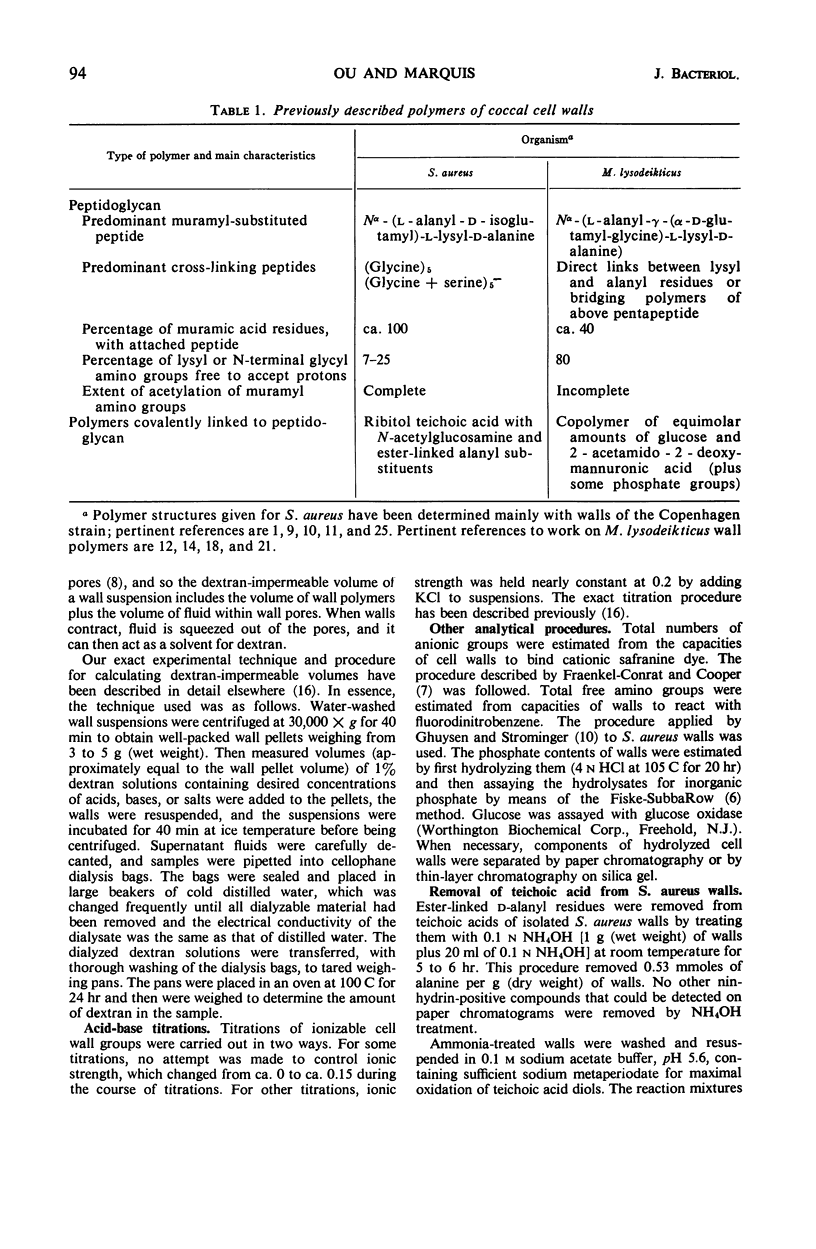Abstract
Isolated cell walls of Staphylococcus aureus and Micrococcus lysodeikticus were found to expand and contract in response to changes in environmental pH and ionic strength. These volume changes, which could amount to as much as a doubling of wall dextran-impermeable volume, were related to changes in electrostatic interactions among fixed, ionized groups in wall polymers, including peptidoglycans. S. aureus walls were structurally more compact in the hydrated state and had a higher maximum charge density than M. lysodeikticus walls. However, they were less responsive to changes in electrostatic interactions, apparently because of less mechanical compliance. In media of nearly neutral pH, S. aureus walls had a net positive charge whereas M. lysodeikticus walls had a net negative charge. These charge differences were reflected in Donnan distributions of mobile ions between wall phases and bulk medium phases. Cell walls of unfractionated cocci also could be made to swell and contract, and wall tonus in intact cells appeared to be set partly by electrostatic interactions and partly by mechanical tension in the elastic structures due to cell turgor pressure. The experimental results led to the conclusions that bacterial cell walls have many of the properties of polyelectrolyte gels and that peptidoglycans are flexible polymers. A reasonable mechanical model for peptidoglycan structure might be a sort of three-dimensional rope ladder with relatively rigid, polysaccharide rungs and relatively flexible polypeptide ropes. Thus, the peptidoglycan network surrounding cocci appeared to be predominantly an elastic restraining structure rather than a rigid shell.
Full text
PDF









Selected References
These references are in PubMed. This may not be the complete list of references from this article.
- BADDILEY J. Teichoic acids in walls and cells of grampositive bacteria. Fed Proc. 1962 Nov-Dec;21:1084–1088. [PubMed] [Google Scholar]
- BLACK S. H., GERHARDT P. Permeability of bacterial spores. IV. Water content, uptake, and distribution. J Bacteriol. 1962 May;83:960–967. doi: 10.1128/jb.83.5.960-967.1962. [DOI] [PMC free article] [PubMed] [Google Scholar]
- BRITT E. M., GERHARDT P. Bacterial permeability; total uptake of lysine by intact cells, protoplasts, and cell walls of Micrococcus lysodeikticus. J Bacteriol. 1958 Sep;76(3):288–293. doi: 10.1128/jb.76.3.288-293.1958. [DOI] [PMC free article] [PubMed] [Google Scholar]
- Carstensen E. L., Marquis R. E. Passive electrical properties of microorganisms. 3. Conductivity of isolated bacterial cell walls. Biophys J. 1968 May;8(5):536–548. doi: 10.1016/s0006-3495(68)86506-3. [DOI] [PMC free article] [PubMed] [Google Scholar]
- Carstensen E. L. Passive electrical properties of microorganisms. II. Resistance of the bacterial membrane. Biophys J. 1967 Sep;7(5):493–503. doi: 10.1016/S0006-3495(67)86600-1. [DOI] [PMC free article] [PubMed] [Google Scholar]
- GERHARDT P., JUDGE J. A. POROSITY OF ISOLATED CELL WALLS OF SACCHAROMYCES CEREVISIAE AND BACILLUS MEGATERIUM. J Bacteriol. 1964 Apr;87:945–951. doi: 10.1128/jb.87.4.945-951.1964. [DOI] [PMC free article] [PubMed] [Google Scholar]
- GHUYSEN J. M., STROMINGER J. L. STRUCTURE OF THE CELL WALL OF STAPHYLOCOCCUS AUREUS, STRAIN COPENHAGEN. I. PREPARATION OF FRAGMENTS BY ENZYMATIC HYDROLYSIS. Biochemistry. 1963 Sep-Oct;2:1110–1119. doi: 10.1021/bi00905a035. [DOI] [PubMed] [Google Scholar]
- GHUYSEN J. M., STROMINGER J. L. STRUCTURE OF THE CELL WALL OF STAPHYLOCOCCUS AUREUS, STRAIN COPENHAGEN. II. SEPARATION AND STRUCTURE OF DISACCHARIDES. Biochemistry. 1963 Sep-Oct;2:1119–1125. doi: 10.1021/bi00905a036. [DOI] [PubMed] [Google Scholar]
- Ghuysen J. M., Bricas E., Lache M., Leyh-Bouille M. Structure of the cell walls of Micrococcus lysodeikticus. 3. Isolation of a new peptide dimer, N-alpha-[L-alanyl-gamma-(alpha-D-glutamylglycine)]-L-lysyl-D-alanyl-N-alpha-[L-alanyl-gamma-(alpha-D-glutamylglycine)]-L-lysyl-D-alanine. Biochemistry. 1968 Apr;7(4):1450–1460. doi: 10.1021/bi00844a030. [DOI] [PubMed] [Google Scholar]
- Ghuysen J. M. Use of bacteriolytic enzymes in determination of wall structure and their role in cell metabolism. Bacteriol Rev. 1968 Dec;32(4 Pt 2):425–464. [PMC free article] [PubMed] [Google Scholar]
- Leyh-Bouille M., Ghuysen J. M., Tipper D. J., Stominger J. L. Structure of the cell wall of Micrococcus lysodeikticus. I. Study of the structure of the glycan. Biochemistry. 1966 Oct;5(10):3079–3090. doi: 10.1021/bi00874a001. [DOI] [PubMed] [Google Scholar]
- MARQUIS R. E., GERHARDT P. RESPIRATION-COUPLED AND PASSIVE UPTAKE OF ALPHA-AMINOISOBUTYRIC ACID, A METABOLICALLY INERT TRANSPORT ANALOGUE, BY BACILLUS MEGATERIUM. J Biol Chem. 1964 Oct;239:3361–3371. [PubMed] [Google Scholar]
- Marquis R. E. Salt-induced contraction of bacterial cell walls. J Bacteriol. 1968 Mar;95(3):775–781. doi: 10.1128/jb.95.3.775-781.1968. [DOI] [PMC free article] [PubMed] [Google Scholar]
- PERKINS H. R. A polymer containing glucose and aminohexuronic acid isolated from the cell walls of micrococcus lysodeikticus. Biochem J. 1963 Mar;86:475–483. doi: 10.1042/bj0860475. [DOI] [PMC free article] [PubMed] [Google Scholar]
- SALTON M. R. Studies of the bacterial cell wall. VIII. Reaction of walls with hydrazine and with fluorodinitrobenzene. Biochim Biophys Acta. 1961 Sep 16;52:329–342. doi: 10.1016/0006-3002(61)90682-5. [DOI] [PubMed] [Google Scholar]
- Sharon N., Jeanloz R. W. A procedure for the preparation of gram-quantities of bacterial cell walls. Experientia. 1964 May 15;20(5):253–254. doi: 10.1007/BF02151786. [DOI] [PubMed] [Google Scholar]
- Tipper D. J., Berman M. F. Structures of the cell wall peptidoglycans of Staphylococcus epidermidis Texas 26 and Staphylococcus aureus Copenhagen. I. Chain length and average sequence of cross-bridge peptides. Biochemistry. 1969 May;8(5):2183–2192. doi: 10.1021/bi00833a060. [DOI] [PubMed] [Google Scholar]


